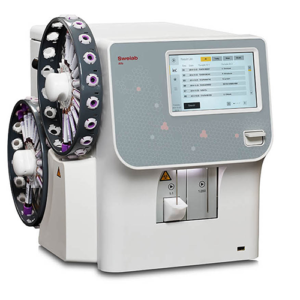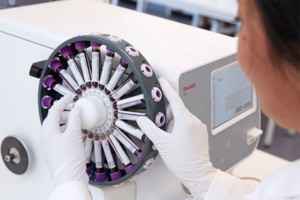When time to diagnosis is critical or you have to prioritize patients for urgent treatment, quick turnaround time (TAT) of test results becomes vitally important. And any gains can make a massive difference – from helping avoid longer than needed hospital stays and higher costs, simplifying and easing routines, to making the optimal and most life-changing decisions for patients. We thought that was pretty important too so that’s why those gains are built into the Swelab Alfa Plus. By design.

Swelab Alfa Plus hematology analyzer
No doubt, performing CBCs is an important part of your patient care and treatment. After all, the sooner you get detailed blood results, the sooner you can make informed treatment decisions. That’s especially true in critical and emergency care where there’s little room – or time – to “just figure things out.”
But in such an urgent, complex, fast-changing and often pressurized environment, you need CBCs to be quick and easy to perform, accurate and always available. And, as a result, those needs have informed many of the design features of our Swelab Alfa Plus automated hematology analyzer.
1. The sooner, the better
Tailored to clinics or smaller hospital laboratories, Swelab Alfa Plus brings hematology analysis closer to the patient – and so quicker results and a potentially quicker transition to diagnosis and treatment than relying on a central laboratory.
What’s more, with the micro-pipette adapter (MPA), there is the option to take and analyze a capillary sample. Unlike venous samples that may also mean a wait for a phlebotomist, the collection procedure with a finger-stick takes seconds, and then just under a minute to get the results. Which can mean critical time saved for patients in desperate need of diagnosis or monitoring of their condition, and a timely decision on the next treatment.

MPA finger-stick
2. Results you can trust
Swelab Alfa Plus uses well-proven measurement technologies to provide accurate results. For 22 parameters – plus histograms for WBC, RBC and PLT – in just one minute. Triggered by an abnormal histogram shape or values exceeding the defined reference interval, the analysis software also displays information messages related to pathology that may be present in the sample. Giving you early warning to keep you in control.
But it doesn’t end there. The key to accurate results is accurate input and proper handling of the blood sample. That’s why Swelab Alfa Plus features space-saving autosampler wheels that ensure proper mixing of the sample before analysis. And a high-precision shear valve and reagent pipettes with optical sensors enable precise sample aspiration and dilution. While measuring pipettes, equipped with liquid start and stop sensors, ensure that a correct volume is used for counting.

Swelab Alfa Plus sampler model
3. Ready when you are
Being constantly available and ready to use is critical when time is of the essence but also to ensure a smoother, less stressful workflow. As a result, it’s important to have design features that maximize uptime and availability.
The closed shear valve design minimizes leakage risk, which in turn cuts down on maintenance. Same for the absence of moving parts in the dilution system. While clogging is prevented by the low-maintenance valve design as well as a high-voltage burning of the aperture (based on generated air bubbles) that is automatically carried out, but only when needed to reduce wear and tear.
Furthermore, to minimize user intervention and free you up for more important patient care, the analyzer performs automatic wash during standby.
Speed, accuracy and availability – which leads to short analysis times, reliable and actionable results, and low maintenance. Swelab Alfa Plus is designed with you and your patients in mind.
If you are interested in digging deeper and finding out exactly how Swelab Alfa Plus can help you and your patients in your environment, just click the link.

Swelab Alfa Plus family





